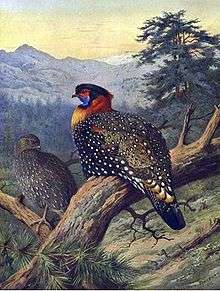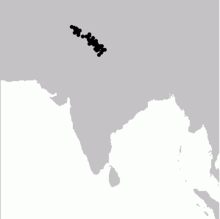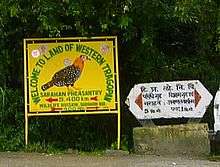Western tragopan
| Western tragopan | |
|---|---|
 | |
| Scientific classification | |
| Kingdom: | Animalia |
| Phylum: | Chordata |
| Class: | Aves |
| Order: | Galliformes |
| Family: | Phasianidae |
| Subfamily: | Phasianinae |
| Genus: | Tragopan |
| Species: | T. melanocephalus |
| Binomial name | |
| Tragopan melanocephalus Gray, 1829 | |
 | |
The western tragopan or western horned tragopan (Tragopan melanocephalus) is a medium-sized brightly plumed pheasant found along the Himalayas from north-eastern districts of Khyber Pakhtunkhwa province in northern Pakistan in the west to Uttarakhand within India to the east. The species is highly endangered and globally threatened.
Identification
The male is very dark, grey and black with numerous white spots, each spot bordered with black and deep crimson patches on the sides and back of the neck. The throat is bare with blue skin while the bare facial skin is red. They have a small black occipital crest. Females have pale brownish-grey upper parts finely vermiculated and spotted with black, and most of the feathers have black patches and central white streaks. Immature males resemble females, but are larger with longer legs and a variable amount of black on the head and red on neck.
Males weigh 1.8–2.2 kg (4.0–4.9 lb) and females weigh 1.25–1.4 kg (2.8–3.1 lb).[2] The males vary in length from 55–60 cm (22–24 in) while the females are 48–50 cm (19–20 in).
Distribution
Five populations are known from Kohistan, Kaghan valley, Kishtwar, Chamba, Kullu and an area east of the Satluj river. They are found from an altitude of 1,750 to 3,600 m, going higher in summer. Their preferred habitat is the dense understorey of temperate, subalpine and broad-leaved forest.
Habits
It inhabits upper temperate forests between 2,400 and 3,600 m in summer, and in winter, dense coniferous and broad-leaved forests between 2,000 and 2,800 m elevations. The western tragopan is mostly arboreal but feeds on the ground. They feed mostly on leaves, shoots and seeds, but also consume insects and other invertebrates. Like most pheasants, they roost in trees singly or in pairs except during nesting.
During display, the males show the throat inflated into lappets that appear purple with pink margins. They also display blue horns with a fancied resemblance to those of the Greek mythological god Pan, whence the name tragopan (tragos "goat" + Pan). During the display they call and the song is a loud two-note ringing wou-weee which is repeated every second for long periods. The breeding season is May and June. They build their nests in low tree hollows.
They are sensitive to anthropogenic disturbance and avoid disturbed habitats (for instance, hydro-electric project development sites).[3]
Status

The western tragopan is considered the rarest of all living pheasants. Its range is very restricted. In Kullu District of Himachal Pradesh, this bird is locally called jujurana which means "king of birds". It was accorded the status of state bird of Himachal Pradesh in 2007.
The population of the western tragopan is threatened by several anthropogenic factors throughout its range. The world population is estimated at fewer than 5,000 individuals, including a captive breeding population in Himachal Pradesh which numbered fewer than ten pairs in 2012.[4] CITES has listed this species in Appendix I in order to discourage selling of its feathers. Representing the endemic bird area D02 of Western Himalaya, the western tragopan has been described as a range-restricted species.
Gallery
 by Ustad Mansur 1625
by Ustad Mansur 1625 by D G Elliot 1872
by D G Elliot 1872
References
- ↑ BirdLife International (2013). "Tragopan melanocephalus". IUCN Red List of Threatened Species. Version 2013.2. International Union for Conservation of Nature. Retrieved 26 November 2013.
- ↑ CRC Handbook of Avian Body Masses by John B. Dunning Jr. (Editor). CRC Press (1992), ISBN 978-0-8493-4258-5.
- ↑ Jolli, Virat & Pandit, M. K. (2011). "Monitoring pheasants (Phasianidae) in the Western Himalayas to measure the impact of hydro-electric projects". The Ring 33: 37-46. doi:10.2478/v10050-011-0003-7
- ↑ "Western Tragopan Tragopan melanocephalus". BirdLife International. Retrieved 9 September 2015.
- Rasmussen, P.C & Anderton, J. C. (2005) Birds of South Asia. The Ripley Guide. Smithsonian Institution and Lynx Edicions.
External links
- Tragopanery The Valendries
- Home of Western Tragopan
- (Government of Himachal Pradesh )
